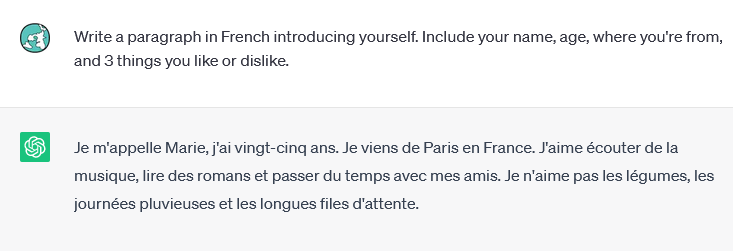Chat GPT and the World Language Classroom
I wanted to see if Chat GPT could replicate a believable student voice. Here are the results of my experiment… and what it means for teachers.
Me into ChatGPT: “Write a conversation where a teacher asks a student whether they used Google Translate on their French homework. The student denies it at first, but after repeated questioning admits they did get help from a translator.”
ChatGPT’s response:
Teacher: Good morning, Sarah. I wanted to talk to you about your recent French homework. It seems quite different from your previous work. Did you use Google Translate for assistance?
Student: No, I didn't use Google Translate, I promise. I worked on it all by myself.
Teacher: Are you sure? The sentences in your homework appear to be very accurate and advanced compared to your previous assignments.
“It’s misguided to shield or ban students from using tools like Google Translate or Chat GPT... and what’s more, it’s futile.”
Student: Well, I might have used a dictionary for some words, but I didn't use Google Translate. I wanted to challenge myself and improve my French skills.
Teacher: Sarah, I appreciate your enthusiasm, but I must insist on honesty. It's important that you complete your assignments independently to truly understand the language. Did you use any online translation tools?
Student: Okay, you caught me. I did use Google Translate for some parts of the homework. I was struggling with a few sentences, and I thought it would be helpful. I'm sorry for not being truthful earlier.
Teacher: Thank you for being honest, Sarah. I understand that learning a new language can be challenging, but using translation tools hinders your progress. Let's work together to improve your French skills without relying on external assistance. I'm here to support you.
End of Chat GPT generated content!
Well, given that it’s computer generated, it’s pretty good. But I’m relieved that I think I could still do better. The conversation doesn’t seem natural to me, especially as it gets further on. Why did Sarah decide to be honest on the third question? In my experience kids stick to their story once they commit. On the other hand, I don’t think robo-teacher did a good job of questioning the child; I would have pulled out specific evidence from their work and asked them things like “Tell me about this word. What does it mean?” and “You used a really complicated verb tense here. Tell me about it.” That’s where I usually get the confession. Overall, the dialogue sounds wooden and formulaic.
I give Chat GPT 7/10 on this one.
World language teachers have been dealing with these same issues for years. Google Translate has been around for almost two decades, and has deeply influenced the way teaching and learning occurs in our classes. Some of this influence has been bad, but some has been incredibly positive. Coaching and guiding our students in its use is part of our job as teachers.
Chat GPT and AI is no different. We have to prepare students not only to use today’s technology proficiently, but to be effective users of technology that hasn’t yet been invented. That’s where I think it’s misguided to try to shield or ban students from using tools like Google Translate or Chat GPT. And not only is it misguided - it’s futile.
So my first big question is, “what can this tool actually do?”. If I’m a student who is looking for shortcuts, will Chat GPT be able to fool my teacher?
I decided to put some of my actual writing prompts into Chat GPT to see if it could give me believable student samples. Here’s what I got!
ChatGPT with Novice Level Writing Prompts
Prompt 1a: Write a paragraph in (target language) introducing yourself. Include your name, age, where you’re from, and 3 things you like or dislike.
ChatGPT’s answer: My name is Sarah. I am 25 years old. I am from New York. I like reading books, listening to music, and spending time with my friends. I dislike waking up early, doing laundry, and eating spicy food.
That’s beautiful, polished English. As an ELL teacher I would be suspicious of some of the vocabulary, especially in the last sentence. I also probably would teach my students the phrase ‘don’t like’ rather than dislike, which is a subtle clue that the student may have received outside help. I would definitely have questions about this submission.
I tried again:
Prompt 1b. Write a paragraph in (target language) introducing yourself like a beginner TL student. Include your name, age, where you’re from, and 3 things you like or dislike. Be very simple. Include at least 2 grammar errors.
Chat GPT: Me name is John. I am 30 years old. I am from Brazil. I like play soccer, go to beach, and watch movies. I no like vegetables, wake up early, and do homeworks.
This was a lot better (as in, less suspicious). It looks like something a beginner would write. Well played, Chat GPT. Well played.
Here are the French and Spanish answers to the same prompts.
Prompt 1a French
Prompt 1b French
Prompt 1a Spanish
Prompt 1b Spanish
My assessment on the French and Spanish prompts are similar. I would be suspicious of the vocabulary choices and some structures in the first responses, but the second responses in both languages would be likely to fool me.
ChatGPT with Intermediate Level Writing Prompts
“Coaching and guiding students in the use of new technology is part of our job as teachers.”
Prompt 2a: In (target lang) describe what you used to be like as a child and compare to what you are like today. Include at least four different imperfect verbs and four present tense verbs. Include at least 3 adverbs of time.
Chat GPT: When I was a child, I used to be very curious and imaginative. I would often spend hours playing with my toys and creating adventures in my mind. I loved exploring the outdoors and discovering new things. I would frequently visit my grandparents and spend summers at their house. Nowadays, I am more focused and responsible. I work hard and strive for success in my career. I enjoy spending time with my friends, going on trips, and trying new hobbies. Currently, I often exercise to stay healthy and read books to relax. I still cherish my childhood memories and occasionally reminisce about those carefree days.
Like with the novice-level prompt, this is really too good for most language learners and would raise my suspicions. So, I revised my prompt:
Prompt 2b: All of prompt 2a, and “Write very simply and include some errors, like a beginning student.”
Chat GPT: When I was a child, I was very playfull and happy. I used to play with my friends all the time and watch cartoons on the TV. I likedsweets and never liked vegetables. I always runned around and played outside. Now, I am more serious and workhard. I go to the gym sometimes and reads books. I still watch TV, but not as much. Nowadays, I eat more healthy and sleeps early.
I think it’s interesting that it chose to make errors by eliminating spaces between words. That’s not a common error in my experience. The spelling and verb errors are more believable, and a couple of the word choices are unusual (sweets = British English, and ‘nowadays’ is unusual wording). This one might fool me… or it might not.
French and Spanish responses to prompts 2a and 2b.
Prompt 2a French
Prompt 2b French
Prompt 2a Spanish
Prompt 2b Spanish
In each case, the first answer would raise my suspicion. But, if the student worked with the platform a bit (or added their own content) they could probably fool me.
So, I think what this established for me is that Yes, Chat GPT can write believable student-level writing for world language classes. The kids are going to be inclined to use it, so we must adapt our classroom practices.
What to do?
I have a few ideas, but you’re going to have to wait for my next installment! Stay tuned!











